Optimization of GOPS-Based Functionalization Process and Impact of Aptamer Grafting on the Si Nanonet FET Electrical Properties as First Steps towards Thrombin Electrical Detection
Abstract
1. Introduction
2. Materials and Methods
2.1. Fabrication of the Aptamer-Based Si NN–FETs
2.1.1. Elaboration of Al2O3 Passivated Si NN–FETs
2.1.2. Oligonucleotides
2.1.3. DNA Probe Grafting and Hybridization
2.2. Characterization Techniques
2.2.1. Fluorescence
2.2.2. Wettability
2.2.3. Atomic Force Microscopy (AFM)
2.2.4. Transmission Electron Microscopy (TEM)
2.2.5. Electrical Characterization
3. Results and Discussion
3.1. APTES Based Functionalization Related Issues
3.2. Optimization of DNA Grafting by UV-Assisted GOPS-Based Functionalization
3.3. Chemical Composition after DNA Hybridization on Al2O3 Passivated Si NN-FETs
3.4. Surface Morphology Evolution at the Main Steps of the Biomodification Process
3.5. Electrical Characterization
3.5.1. Impact of Grafted DNA Probes on FET Electrical Properties
3.5.2. Precautions in the Experimental Protocol
3.5.3. Detailed Study of the Grafting Step
4. Conclusions
- The pH of the solutions used must be equal to the PZC of the surface materials or the surface material must be chosen so that its PZC is equal to the pH of the solutions.
- In the case of dry detection, the rate of hydration of the surface has an impact on the electrical response and must therefore be controlled by the storage conditions and/or the time before measurement.
- In the case where multimer formation may occur, it is important to choose the ions in solution according to the desired structure, single-strands or multimers.
- It should be noted that the sequence of bases in the DNA strand plays a role on the electrical response of the device.
Author Contributions
Funding
Conflicts of Interest
Appendix A. Amino-Silane (APTES)-Based Biofunctionalization Protocol
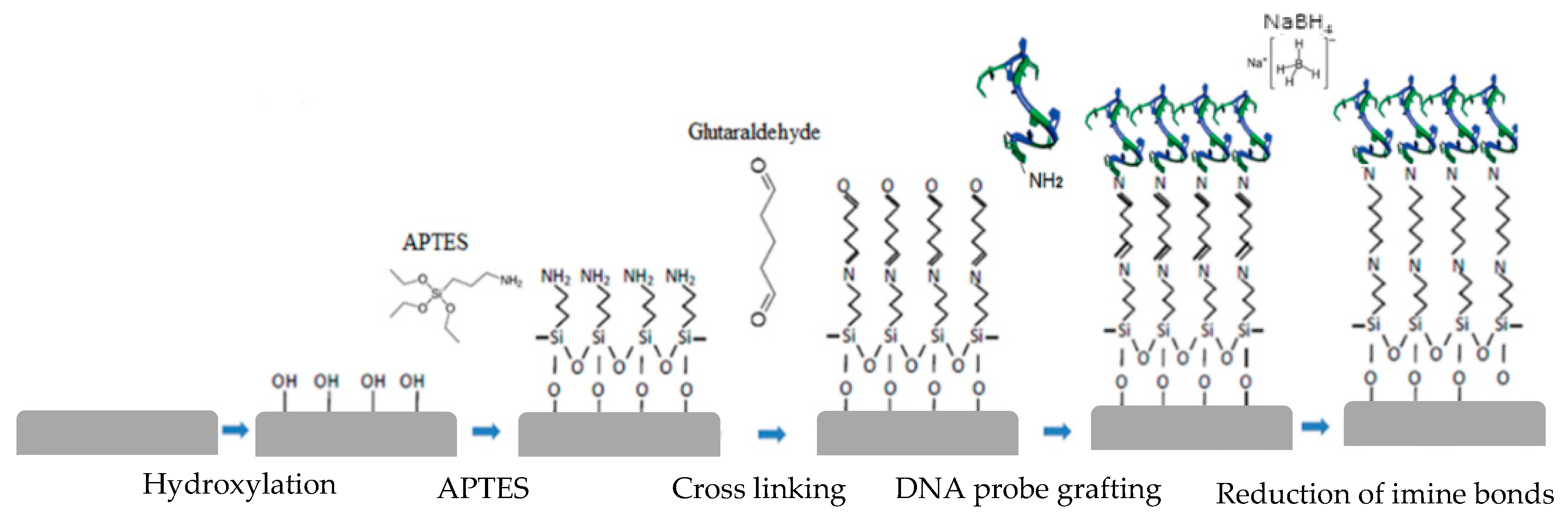
Appendix B. Epoxy-Silane (GOPS)-Based Biofunctionalization Protocol

Appendix C. Analysis of Hybridization Capacity in Time of Sequence 2 Probe
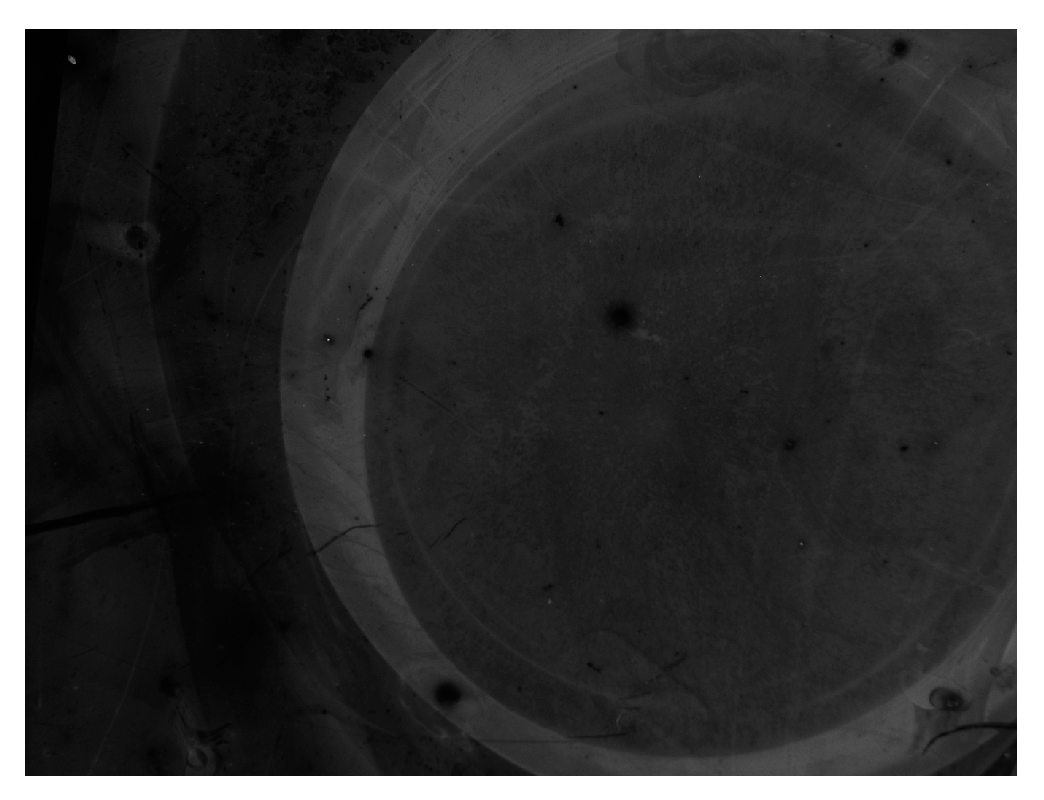
References
- Zhang, G.J.; Ning, Y. Silicon nanowire biosensor and its applications in disease diagnostics: A review. Anal. Chim. Acta 2012, 749, 1–15. [Google Scholar] [CrossRef] [PubMed]
- Ahmad, R.; Mahmoudi, T.; Ahn, M.S.; Hahn, Y.B. Recent advances in nanowires-based field-effect transistors for biological sensor applications. Biosens. Bioelectron. 2018, 100, 312–325. [Google Scholar] [CrossRef] [PubMed]
- Tran, D.P.; Pham, T.T.T.; Wolfrum, B.; Offenhäusser, A.; Thierry, B. CMOS-compatible silicon nanowire field-effect transistor biosensor: Technology development toward commercialization. Materials (Basel) 2018, 11, 785. [Google Scholar] [CrossRef] [PubMed]
- M. Nuzaihan, M.N.; Hashim, U.; Arshad, M.K.M.; Ruslinda, A.R.; Rahman, S.F.A.; Fathil, M.F.M.; Ismail, M.H. Top-down nanofabrication and characterization of 20 nm silicon nanowires for biosensing applications. PLoS ONE 2016, 11, e0152318. [Google Scholar]
- Jayakumar, G.; Legallais, M.; Hellström, P.E.; Mouis, M.; Pignot-Paintrand, I.; Stambouli, V.; Ternon, C.; Ostling, M. Wafer-scale HfO2 encapsulated silicon nanowire field effect transistor for efficient label-free DNA hybridization detection in dry environment. Nanotechnology 2019, 30, 184002. [Google Scholar] [CrossRef]
- Gao, A.; Lu, N.; Wang, Y.; Dai, P.; Li, T.; Gao, X.; Wang, Y.; Fan, C. Enhanced sensing of nucleic acids with silicon nanowire field effect transistor biosensors. Nano Lett. 2012, 12, 5262–5268. [Google Scholar] [CrossRef]
- Dai, P.; Gao, A.; Lu, N.; Li, T.; Wang, Y. A back-gate controlled silicon nanowire sensor with sensitivity improvement for DNA and pH detection. Jpn. J. Appl. Phys. 2013, 52, 121301. [Google Scholar] [CrossRef]
- Noor, M.O.; Krull, U.J. Silicon nanowires as field-effect transducers for biosensor development: A review. Anal. Chim. Acta 2014, 825, 1–25. [Google Scholar] [CrossRef]
- Kim, T.; Park, J.; Jin, H.J.; Lee, H.; Byun, K.E.; Lee, C.S.; Kim, K.S.; Hong, B.H.; Kim, T.H.; Hong, S. Graphene nanonet for biological sensing applications. Nanotechnology 2013, 24, 375302. [Google Scholar] [CrossRef]
- Balasubramanian, K.; Kern, K. 25th anniversary article: Label-free electrical biodetection using carbon nanostructures. Adv. Mater. 2014, 26, 1154–1175. [Google Scholar] [CrossRef]
- Wanekaya, A.K.; Chen, W.; Myung, N.V.; Mulchandani, A. Nanowire-based electrochemical biosensors. Electroanalysis 2006, 18, 533–550. [Google Scholar] [CrossRef]
- Serre, P.; Ternon, C.; Stambouli, V.; Periwal, P.; Baron, T. Fabrication of silicon nanowire networks for biological sensing. Sensors Actuators B Chem. 2013, 182, 390–395. [Google Scholar] [CrossRef]
- Nguyen, T.T.T.; Cazimajou, T.; Legallais, M.; Arjmand, T.; Nguyen, V.H.; Mouis, M.; Salem, B.; Robin, E.; Ternon, C. Monolithic fabrication of nano-to-millimeter scale integrated transistors based on transparent and flexible silicon nanonets. Nano Futur. 2019, 3, 025002. [Google Scholar] [CrossRef]
- Nguyen, T.T.T.; Legallais, M.; Morisot, F.; Cazimajou, T.; Stambouli, V.; Mouis, M.; Salem, B.; Ternon, C. First evidence of superiority of Si nanonet field effect transistors over multi-parallel Si nanowire ones in view of electrical DNA hybridization detection. Mater. Res. Express 2019, 6, 016301. [Google Scholar] [CrossRef]
- Ternon, C.; Serre, P.; Lebrun, J.M.; Brouzet, V.; Legallais, M.; David, S.; Luciani, T.; Pascal, C.; Baron, T.; Missiaen, J.M. Low Temperature Processing to Form Oxidation Insensitive Electrical Contact at Silicon Nanowire/Nanowire Junctions. Adv. Electron. Mater. 2015, 1, 1500172. [Google Scholar] [CrossRef]
- Zhang, Y.; Lai, B.S.; Juhas, M. Recent advances in aptamer discovery and applications. Molecules 2019, 24, 941. [Google Scholar] [CrossRef]
- Gao, S.; Hu, B.; Zheng, X.; Liu, D.; Sun, M.; Qin, J.; Zhou, H.; Jiao, B.; Wang, L. Study of the binding mechanism between aptamer GO18-T-d and gonyautoxin 1/4 by molecular simulation. Phys. Chem. Chem. Phys. 2016, 18, 23458–23461. [Google Scholar] [CrossRef] [PubMed]
- Deng, B.; Lin, Y.; Wang, C.; Li, F.; Wang, Z.; Zhang, H.; Li, X.F.; Le, X.C. Aptamer binding assays for proteins: The thrombin example—A review. Anal. Chim. Acta 2014, 837, 1–15. [Google Scholar] [CrossRef]
- Di Cera, E. Thrombin. Mol. Aspects Med. 2008, 29, 203–254. [Google Scholar] [CrossRef]
- Demes, T.; Morisot, F.; Legallais, M.; Calais, A.; Pernot, E.; Pignot-Paintrand, I.; Ternon, C.; Stambouli, V. DNA grafting on silicon nanonets using an eco-friendly functionalization process based on epoxy silane. Mater. Today Proc. 2019, 6, 333–339. [Google Scholar] [CrossRef]
- Schüler, T.; Nykytenko, A.; Csaki, A. UV cross-linking of unmodified DNA on glass surfaces. Anal. Bioanal. Chem. 2009, 1097–1105. [Google Scholar] [CrossRef] [PubMed]
- Wu, B.Q.; Ma, W.; Shi, R.; Zhang, B.; Mao, X.; Zheng, W. An Activated GOPS-poly-L-Lysine-Coated Glass Surface for the Immobilization of 60mer Oligonucleotides. Eng. Life Sci. 2005, 5, 466–470. [Google Scholar] [CrossRef]
- Escorihuela, J.; Puchades, R.; Maquieira, A. Development of Oligonucleotide Microarrays onto Si-Based Surfaces via Thioether Linkage Mediated by UV Irradiation. Bioconjug. Chem. 2012, 23, 2121–2128. [Google Scholar] [CrossRef] [PubMed]
- Khoe, C.V.; Chung, L.H.; Murray, V. The sequence specificity of UV-induced DNA damage in a systematically altered DNA sequence. J. Photochem. Photobiol. B Biol. 2018, 183, 88–100. [Google Scholar] [CrossRef]
- Legallais, M.; Nguyen, T.T.T.; Mouis, M.; Salem, B.; Robin, E.; Chenevier, P.; Ternon, C. An innovative large scale integration of silicon nanowire-based field effect transistors. Solid. State. Electron. 2017, 143, 97. [Google Scholar] [CrossRef]
- Nguyen, T.T.T.; Legallais, M.; Morisot, F.; Cazimajou, T.; Mouis, M.; Salem, B.; Stambouli, V.; Ternon, C. On the Development of Label-Free DNA Sensor Using Silicon Nanonet Field-Effect Transistors. Proceedings 2017, 1, 312. [Google Scholar] [CrossRef]
- Serre, P.; Stambouli, V.; Weidenhaupt, M.; Baron, T.; Ternon, C. Silicon nanonets for biological sensing applications with enhanced optical detection ability. Biosens. Bioelectron. 2015, 68, 336–342. [Google Scholar] [CrossRef] [PubMed]
- Fradetal, L.; Bano, E.; Attolini, G.; Rossi, F.; Stambouli, V. A silicon carbide nanowire field effect transistor for DNA detection. Nanotechnology 2016, 27, 235501. [Google Scholar] [CrossRef]
- Dapić, V.; Abdomerović, V.; Marrington, R.; Peberdy, J.; Rodger, A.; Trent, J.O.; Bates, P.J. Biophysical and biological properties of quadruplex oligodeoxyribonucleotides. Nucleic Acids Res. 2003, 31, 2097–2107. [Google Scholar] [CrossRef]
- Diculescu, V.C.; Chiorcea-Paquim, A.M.; Eritja, R.; Oliveira-Brett, A.M. Thrombin-binding aptamer quadruplex formation: AFM and voltammetric characterization. J. Nucleic Acids 2010, 2010, 841932. [Google Scholar] [CrossRef]
- Chiorcea-Paquim, A.M.; Santos, P.V.; Eritja, R.; Oliveira-Brett, A.M. Self-assembled G-quadruplex nanostructures: AFM and voltammetric characterization. Phys. Chem. Chem. Phys. 2013, 15, 9117–9124. [Google Scholar] [CrossRef]
- Marsh, T.C.; Vesenka, J.; Henderson, E. A new DNA nanostructure, the G-wire, imaged by scanning probe microscopy. Nucleic Acids Res. 1995, 23, 696–700. [Google Scholar] [CrossRef]
- Oliviero, G.; D’Errico, S.; Pinto, B.; Nici, F.; Dardano, P.; Rea, I.; De Stefano, L.; Mayol, L.; Piccialli, G.; Borbone, N. Self-assembly of g-rich oligonucleotides incorporating a 3’-3’ inversion of polarity site: A new route towards G-Wire DNA nanostructures. ChemistryOpen 2017, 6, 599–605. [Google Scholar] [CrossRef]
- Varizhuk, A.M.; Protopopova, A.D.; Tsvetkov, V.B.; Barinov, N.A.; Podgorsky, V.V.; Tankevich, M.V.; Vlasenok, M.A.; Severov, V.V.; Smirnov, I.P.; Dubrovin, E.V.; et al. Polymorphism of G4 associates: From stacks to wires via interlocks. Nucleic Acids Res. 2018, 46, 8978–8992. [Google Scholar] [CrossRef] [PubMed]
- WATSON, J.D.; CRICK, F.H. Molecular Structure of Deoxypentose Nucleic Acids. Nature 1953, 171, 738–740. [Google Scholar] [CrossRef] [PubMed]
- Humeník, D.; Chorvát, D.; Novotný, I.; Tvarožek, V.; Oretskaya, T.S.; Hianik, T. AFM images of short oligonucleotides on a surface of supported lipid films. Med. Eng. Phys. 2006, 28, 956–962. [Google Scholar] [CrossRef] [PubMed]
- Heim, T. Transport Électronique dans l’ADN. Ph.D. Thesis, Université des Sciences et. Technologie de Lille 1, Lille, France, December 2002. [Google Scholar]
- Schmid, M. Conformational Dynamics of G-Quadruplex DNA Probed by Time-Resolved Circular Dichroism. Ph.D. Thesis, Université Paris-Saclay, Paris-Saclay, France, December 2017. [Google Scholar]
- Munzar, J.D.; Ng, A.; Juncker, D. Comprehensive profiling of the ligand binding landscapes of duplexed aptamer families reveals widespread induced fit. Nat. Commun. 2018, 9, 343. [Google Scholar] [CrossRef]
- Gulicovski, J.J.; Čerović, L.S.; Milonjić, S.K. Point of zero charge and isoelectric point of alumina. Mater. Manuf. Process. 2008, 23, 615–619. [Google Scholar] [CrossRef]
- Gu, D.; Yalcin, S.; Baumgart, H.; Qian, S.; Baysal, O.; Beskok, A. Electrophoretic Light Scattering for Surface Zeta Potential Measurement of ALD Metal Oxide Films. ECS Trans. 2010, 33, 37–41. [Google Scholar] [CrossRef]
- Armstrong, N.R.; Shepard, V.R. Voltammetric studies of silane-modified SnO2 surfaces in selected aqueous and non-aqueous media. J. Electroanal. Chem. 1980, 115, 253–265. [Google Scholar] [CrossRef]
- Zhang, Q.; Chen, E.C. The Experimental Hardness and Electronegativity of the Purines and Pyrimidines in DNA and RNA Supported by the AM1 Calculation of the Electron Affinities and Ionization Potentials. Biochem. Biophys. Res. Commun. 1995, 217, 755–760. [Google Scholar] [CrossRef] [PubMed]
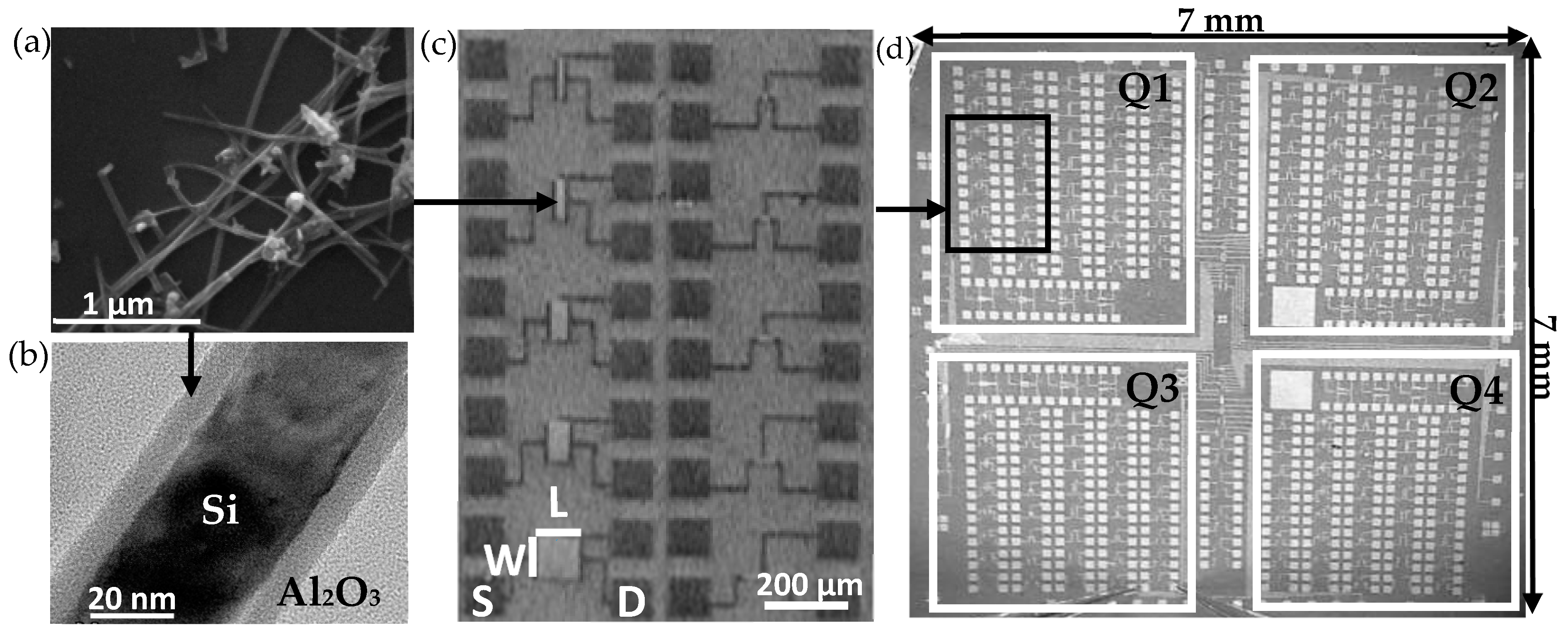
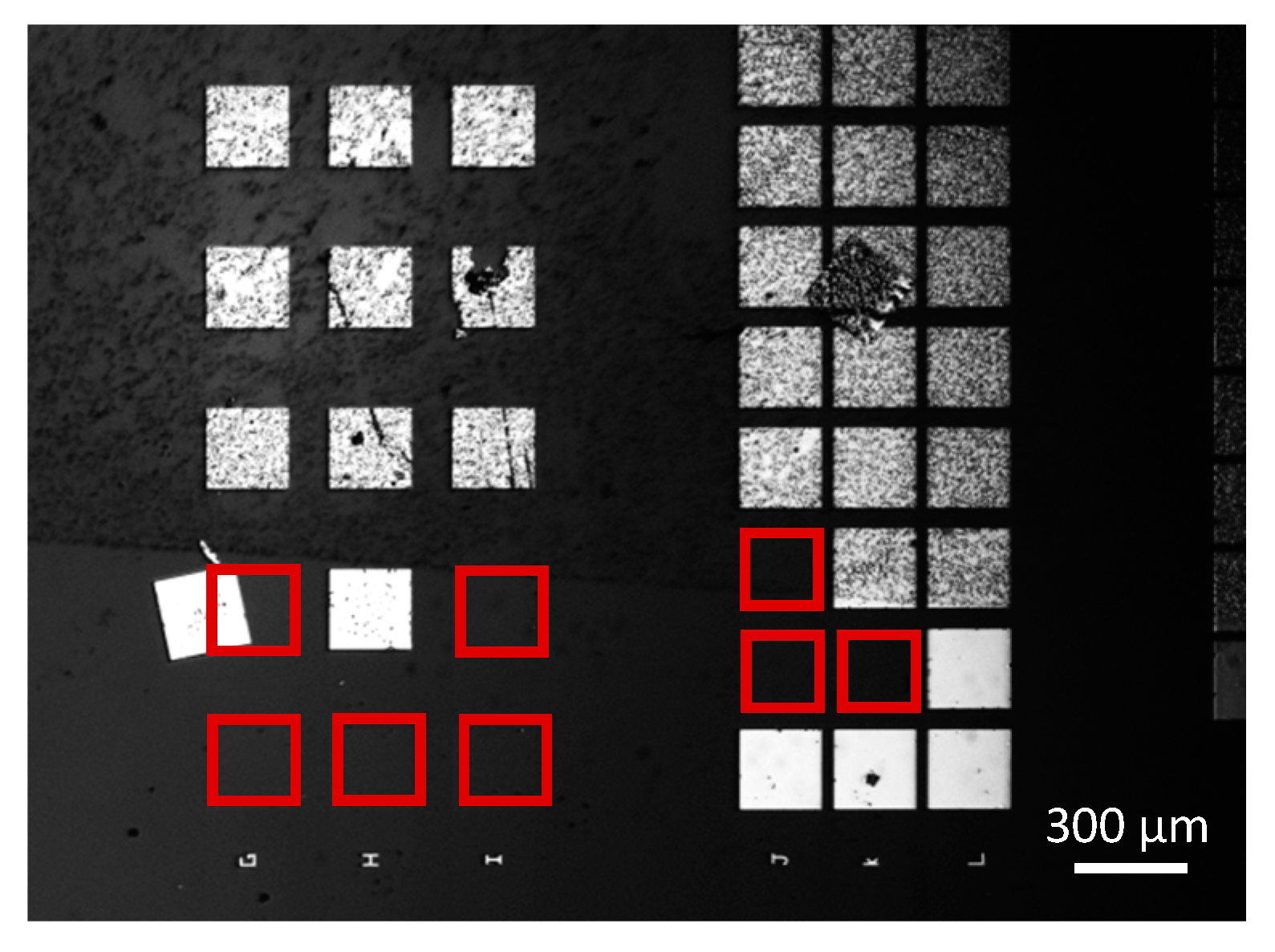
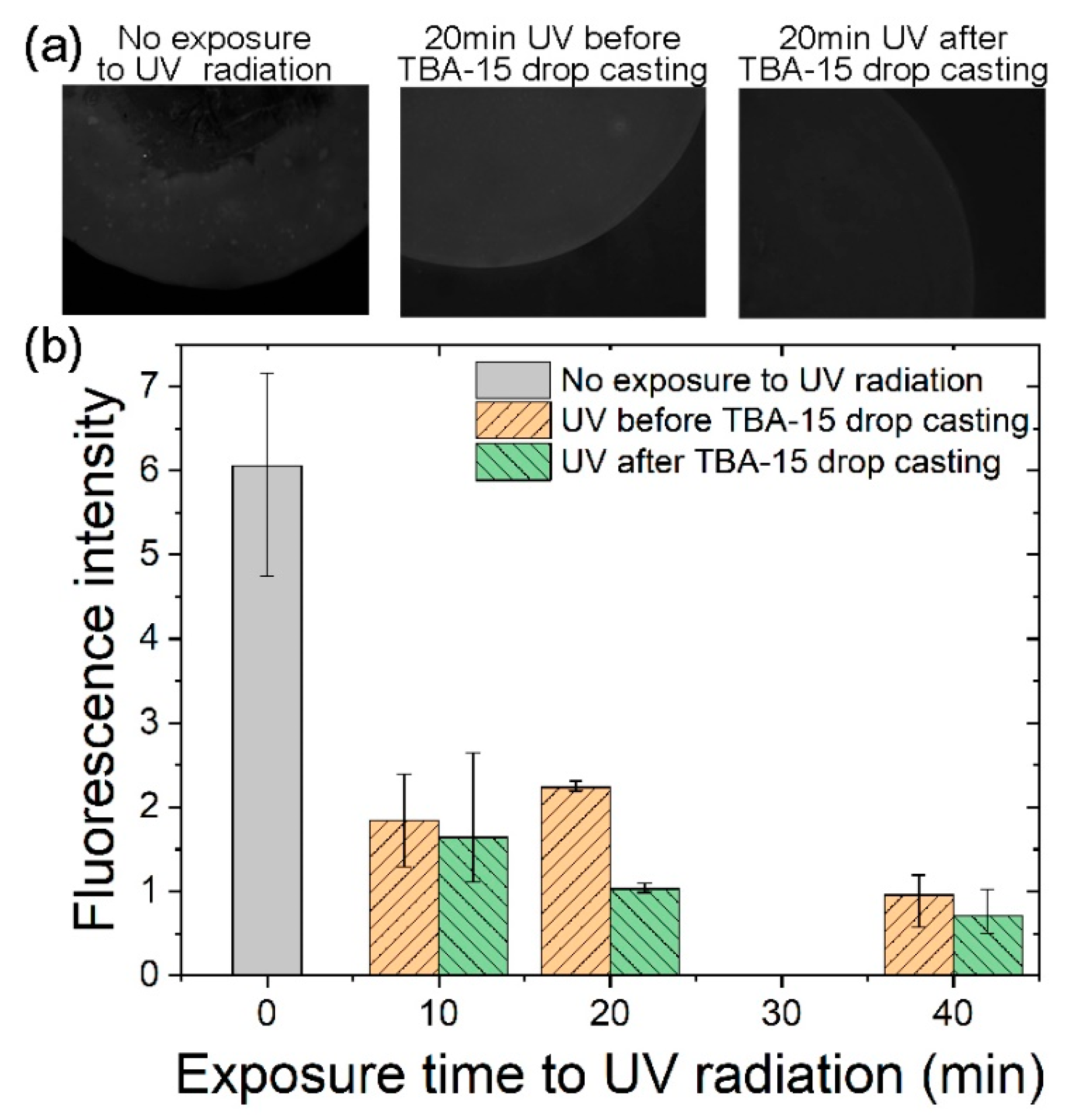
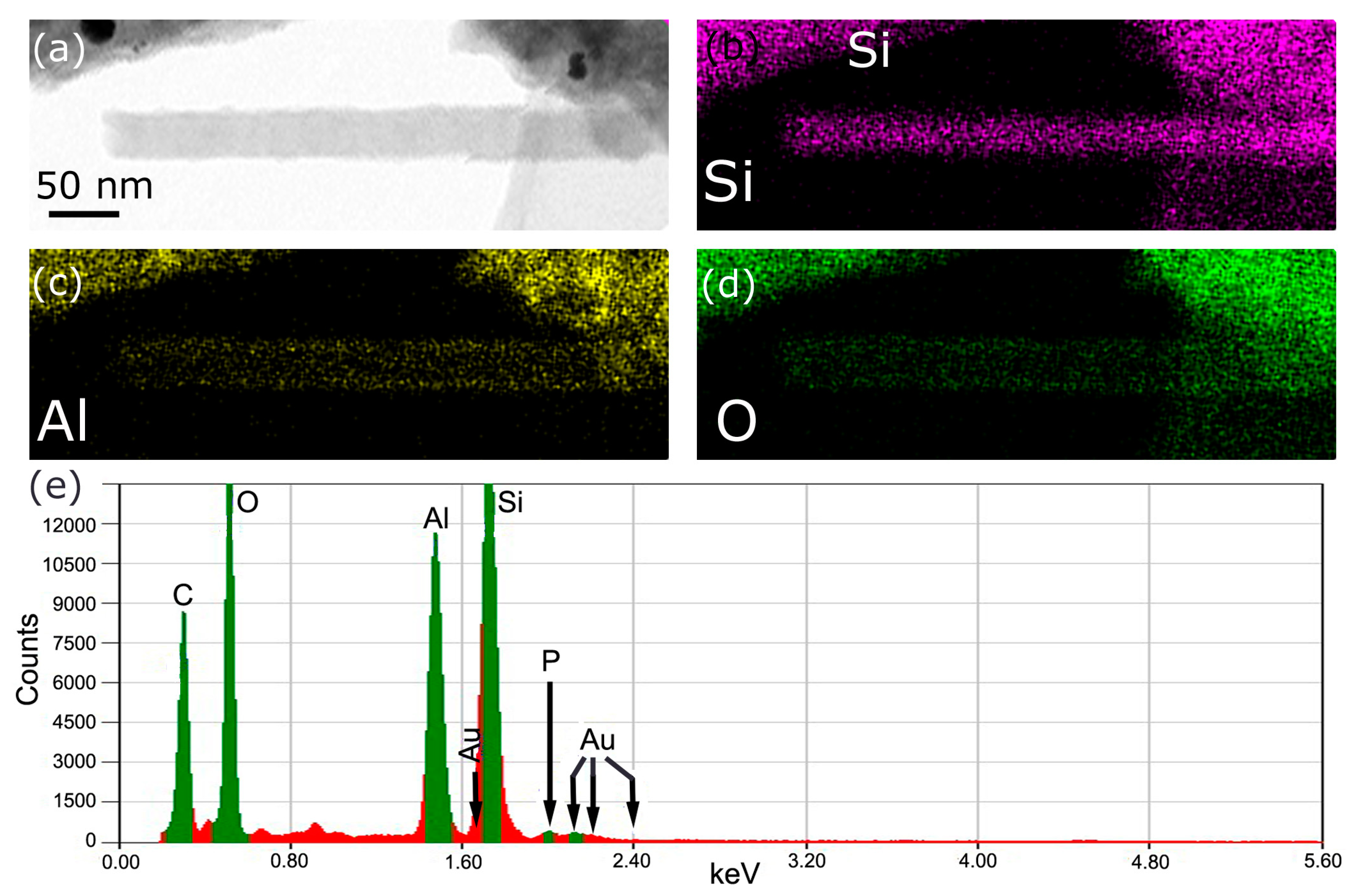
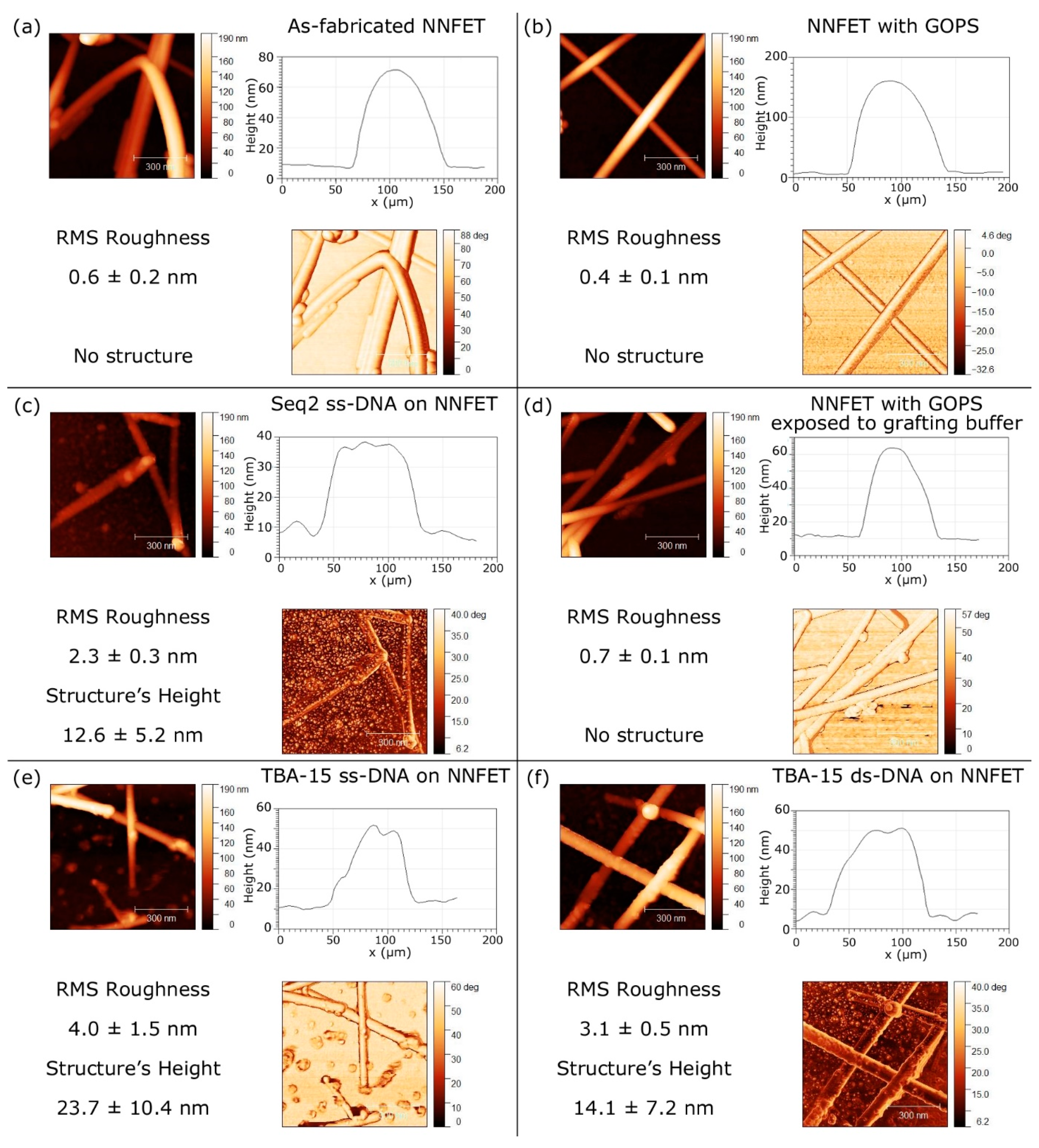
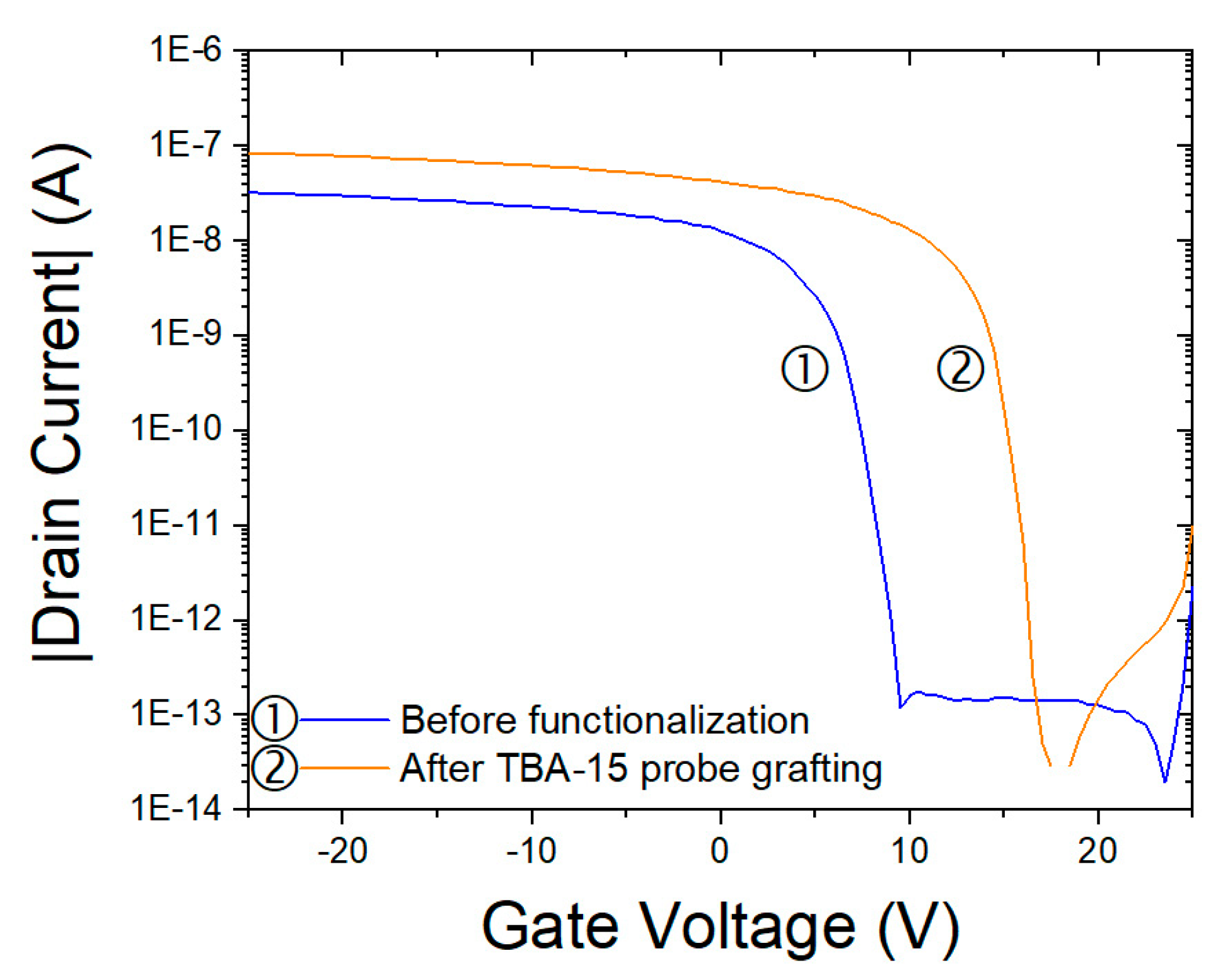



| Name | Sequence | Function | Elongated Length (nm) |
|---|---|---|---|
| TBA–15 | 5′GGTTGGTGTGGTTGGTTTTTT3′–NH2 | Probe | 7.1 |
| Sequence 2 | 5′NH2-TTTTTGATAAACCCACTCTA3′ | Probe | 6.8 |
| cTBA | Cy3-5′CCAACCACACCAACC3′ | Target | 5.1 |
| c-Sequence 2 | Cy3-5′CATAGAGTGGGTTTATCCA3’ | Target | 6.5 |
© 2020 by the authors. Licensee MDPI, Basel, Switzerland. This article is an open access article distributed under the terms and conditions of the Creative Commons Attribution (CC BY) license (http://creativecommons.org/licenses/by/4.0/).
Share and Cite
Vallejo-Perez, M.; Ternon, C.; Spinelli, N.; Morisot, F.; Theodorou, C.; Jayakumar, G.; Hellström, P.-E.; Mouis, M.; Rapenne, L.; Mescot, X.; et al. Optimization of GOPS-Based Functionalization Process and Impact of Aptamer Grafting on the Si Nanonet FET Electrical Properties as First Steps towards Thrombin Electrical Detection. Nanomaterials 2020, 10, 1842. https://doi.org/10.3390/nano10091842
Vallejo-Perez M, Ternon C, Spinelli N, Morisot F, Theodorou C, Jayakumar G, Hellström P-E, Mouis M, Rapenne L, Mescot X, et al. Optimization of GOPS-Based Functionalization Process and Impact of Aptamer Grafting on the Si Nanonet FET Electrical Properties as First Steps towards Thrombin Electrical Detection. Nanomaterials. 2020; 10(9):1842. https://doi.org/10.3390/nano10091842
Chicago/Turabian StyleVallejo-Perez, Monica, Céline Ternon, Nicolas Spinelli, Fanny Morisot, Christoforos Theodorou, Ganesh Jayakumar, Per-Erik Hellström, Mireille Mouis, Laetitia Rapenne, Xavier Mescot, and et al. 2020. "Optimization of GOPS-Based Functionalization Process and Impact of Aptamer Grafting on the Si Nanonet FET Electrical Properties as First Steps towards Thrombin Electrical Detection" Nanomaterials 10, no. 9: 1842. https://doi.org/10.3390/nano10091842
APA StyleVallejo-Perez, M., Ternon, C., Spinelli, N., Morisot, F., Theodorou, C., Jayakumar, G., Hellström, P.-E., Mouis, M., Rapenne, L., Mescot, X., Salem, B., & Stambouli, V. (2020). Optimization of GOPS-Based Functionalization Process and Impact of Aptamer Grafting on the Si Nanonet FET Electrical Properties as First Steps towards Thrombin Electrical Detection. Nanomaterials, 10(9), 1842. https://doi.org/10.3390/nano10091842






